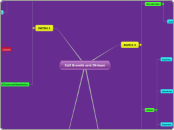Cell Growth and Divison
Section 2
Chromosomes
Prokaryotic Chromosomes
Chromosomes- Packages of DNA
No nucleus for DNA
Chromosome in Cytoplasm
Single Chromosome holds DNA
Loop Shaped Chromosome
Eukaryotic Chromosomes
X Shaped Chromosome
Multiple Chromosomes
Contains Histones and Chromatin
Chromosomes are made of coils
Chromosome in Nucleus
The Cell Cycle
Prokaryotic Cell Cycle
Rapid in ideal conditions
Form of Asexual Reproduction
Binary Fission
Results in Genetically Identical cells
Begins when cells have grown to a certain size
Eukaryotic Cell Cycle
4 Cycles- G1, S, G2, M
G1 Phase- Cell Growth
S Phase- DNA Replication
G2 Phase- Preparation for Mitosis
M Phase- Mitosis and Cytokinesis
Mitosis
Prophase
1st Phase
Longest (About half of time)
Chromosomes Appear
Nuclear Envelope Disappears
Spindle Fibers extend from centrioles
Metaphase
2nd Phase
Shortest (Least time)
Chromosomes Lined Up in Middle
Middle of chromosome(Centromere) lined up with each other
Spindle Fibers attached to each end of chromosomes
Anaphase
3rd Phase
Chromosomes are Ripped Apart
Each half (Chromatid) considered a Chromosome now
Chromosomes move along spindle fibers to opposite sides of cell
Ends when chromosomes are separated and are in 2 groups
Telophase
Last Phase
Chromosomes untangle into a ball of chromatin
Nuclear Envelope re-forms
Spindle Fibers break apart
Mitosis is Done
Cytokenesis
Animal Cells
Cytokinesis- Splits cell into two
Cell Membrane is pinched together
Cell splits into 2 closely equal parts
Each new cell contains a nucleus and organelles
If done correctly, Cells are genetically identical
Plant Cells
Cell Wall isn't flexible enough to pinch
Cell Plate forms between the 2 nuclei
Cell Plate forms a Cell Wall
Forms two new plant cells
If done correctly, Cells are genetically identical
Section 3
Cancer
Causes
Too much Radiation
Chewing/Smoking Tobacco
Defective Genes
Viral Infection
Sun Tanning
Treatments
Surgery
Targeted Radiation
Chemotherapy (Chemicals)
Chemotherapy also corrupts some normal cells
New advances have cured some cancers
Section 1
Limits to Cell Size
Information Overload
Critical Info stored in DNA of cell
DNA does not increase with cell size
Happens when cell is too big
Too much DNA to handle
Causes cell to divide
Exchanging Materials
Waste needs to be removed quickly
Rate of food, oxygen, and waste exchange depends on surface area
SMALL Surface Area: Volume is bad for cell
Surface Area= l x w
Volume= l x w x h
Causes cell to divide
Divison of the Cell
Cell divides to form two "daughter" cells
Process is called Cell Division
Reduces cell volume
Before division, cell replicates DNA
Solves "Information Overload" and "Cell Volume" problems
Cell Division and Reproduction
Asexual Reproduction
One Parent
One cell splits to form Two cells
Simple, Efficient, Effective
Population increase quickly
Child is genetically identical to parent
Sexual Reproduction
2 Parents
Two cells fuse to make one cell
Inherit DNA from both parents
Takes time
Genetically Diverse
Comparing Asexual/Sexual Reproduction
Both are survival strategies
Some organisms can reproduce both ways
Asexual- Fast
Sexual- Slow
Asexual- Genetic Clones
Sexual- Genetically Diverse
Asexual- Can't adapt to conditions Sexual- Adapts to conditions
Section 4
Stem Cells and Developement
Human Developement
Pluripotent- Can make ANY type of cell
Multipotent- Can make a FEW kinds of cells
Human embryo forms a blastocyst after 4 days
Blastocyst- Hollow ball of cells with a cluster of cells inside
Outer cells form tissue to attach to mother
Inner cells for the embryo
Stem Cells
2 TypesEmbryonic and Adult
Unspecialized Cells
Make Different cells
Embryonic is Pluripotent
Adult is Multipotent
Frontiers in Stem Cell Research
Potential Benefits
Make new organs
Repair damaged organs
Repair/Replace damaged cells and tissues
Researchers hope to reverse effects of heart attacks
One way may be to put bone marrow cells into the heart
Ethical Issues
Very few issues with Adult cells
Embryonic cells are Very controversial
Embryonic mus be taken from a new embryo
Some humans argue that embryo is already living
Would be killing a human being
